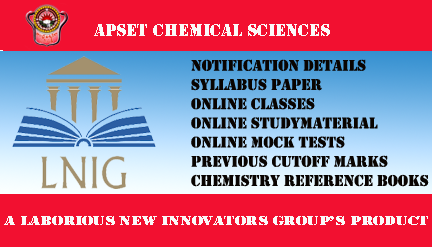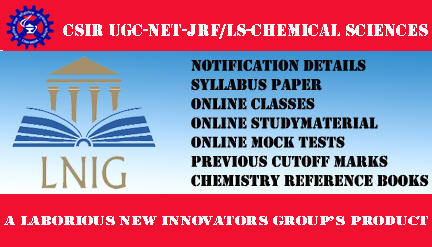Instructor Details
More Courses by LNG CHEMICAL SCIENCES.
Objective Physical Photochemistryby LNG CHEMICAL SCIENCES.
Objective Coordination Chemistryby LNG CHEMICAL SCIENCES.

APPSC GOVERNMENT DEGREE COLLEGE LECTURERS CHEMISTRY ONLINE MOCK TESTSby LNG CHEMICAL SCIENCES.

CSIR UGC NET CHEMICAL SCIENCES ONLINE MOCK TESTSby LNG CHEMICAL SCIENCES.
AP POLICE CHEMICAL SCIENTIFIC ASSISTANTby LNG CHEMICAL SCIENCES.






CHROMIUM (VI) OXIDANTS
CHROMIUM IV OXIDANTS; INTRODUCTION CLASS
TYPES OF CHROMIUM (VI) OXIDISING REAGENTS CLASS
CHROMIUM IV OXIDANTS; CLASS NOTES
• It is a versatile oxidizing reagent ( it can oxidise more no of functional groups).
• In CrO3 chromium is in (+VI) oxidation state, in CrO3 chromium needs ‘6 electrons’ to obeyed octant rule.
• CrO3 is soluble in water, can produce chromic acid, these chromic acid is more reactive than chromium trioxide. (more oxidation property Cr > Mn > Os.).
• Cr (VI) oxidants are mainly occurred by CrO3, H2CrO4, sodium (or) potassium dichromate, chromyl chloride (CrO2Cl2),[CrO2Cl2+CH2Cl2 / CCl4 – Etard reagent, Which is used for hydro formylation (CH3 to CHO)] etc.
Solvents:-
• Cr (VI) oxidizing agents are mostly soluble in inert solvents like di chloro methane, CCl4, acetone, pyridine, acetic acid, acetic anhydride, Ethanol, aqueous H2SO4 (or) dil.HCl , t-BuOH and etc…
• CrO3 is when dissolved in H2O then acidic chromate is formed, CrO3 is when reactant with t-BuOH group, t-Butyl chromate is formed,CrO3 is when treated with acetic anhydride, chromyl acetate,CrO3 is when treated with pyridine pyrinium chromate is formed.
when chromium oxidants are takes place the chromium oxidation number in CrO3 (VI) is changes to +III oxidation state so there is a net transfer of 3 electrons CrO3 oxidations.
Combinations of CrO3 with various solvents as follows:-
1. Chromic acid / CrO3 + H2O / H2CrO4.
2. Jone’s reagent / CrO3 + aq.H2SO4 + acetone.
3. CrO2Cl2 + CCl4 / CHCl2 Etard reagent.
4. Pyridinium Chloro Chromate (PCC) / CrO3 + pyridine + dil.HCl
5. 8NCrO3 + pyridine collin’s reagent.
6. Pyridinium Dichromate (PDC) / CrO3 + Pyridine.
unlike KMno4,CrO3 oxidations are carried under acidic,basic and neutral conditions.
1.CHROMIC ACID / CrO3 + H2O / H2CrO4
• The combination of chromium trioxide with water is called as chromic acid.
• Chromic acid is a very reactive oxidizing reagent of chromium VI oxidants; It can mainly oxidized the alcohols to acids.
• Chromic acid can also oxidized the acid labile groups with presence of alcoholic groups. (Draw back).
• The groups which are labile to acids like epoxides, esters, anhydrides, ethers etc, are called as “acid labile groups”.
• Chromic acid can oxidize alcohols, acid labile groups when both are present, in the given reactant.
• Chromic acid can also oxidized un saturation with respect to alcohols.
Limitations:-(draw backs).
1. It can effect un saturation also, it can oxidized acid labile groups also, it can oxidized alcohols to carboxylic acids.
2 JONE’S REAGENT (CrO3 + aq.H2SO4 + acetone) [0-20oc]
• The combination of CrO3 with aq.H2SO4 in acetone solution at 0-200c is called as “Jone’s reagent” (acidic medium).
• The oxidations which carried by this reagent are called as ‘Jone’s oxidation’.
• Jone’s reagent is a excellent reagent for the oxidation of primary and secondary alcohols.
• Jone’s oxidations are carries under 0-200c temperature.
• Jone’s oxidations when takes place in the presence of primary alcohols carboxylic acids are formed but when these oxidations are carried under at low temparature (0-5oc).The alcoholic oxidations are stopped at aldehyde stage.
• Jone’s reagent is selectively used for the oxidation of alcohols, which are present in with acid labile groups, un saturation that means the oxidation of alcohol only takes place but not un saturation, acid labile groups.
Limitations:-
At high temperature Jone’s reagent can oxidize alcohols up to carboxylic acids (over oxidation products).
To overcome these limitation of Jone’s reagent we can use another reagent namely Collin’s reagent.(8N CrO3 + pyridine).
3. Collin’s reagent (or) collin’s oxidation (or) & Saratte oxidation:- (CrO3 + 2 mole pyridine).
• The combination of CrO3 + 2mole pyridine + CH2Cl2, dichloro methane anhydrous condition (basic medium) are called as Collin’s reagent.
• Collin’s reagent carries under pyridine solvent (basic medium).
• CrO3 is when treated with 2mole of pyridine then chromium trioxide pyridinium complex is formed.
• These complex is involved in the oxidation of primary and secondary alcohols.
• Collin’s reagent is an excellent for the oxidation of primary and secondary alcohols.
• The formed chromium trioxide pyridium complex pyridine complex is in pyridine solvent is used for the primary alcohols to aldehydes.
• These type of oxidations by chromium trioxide pyridinium complex in pyridine solvent (Saratte) is known as “saratte oxidation”.
• Due to saratte oxidations the formed aldehydes (or) ketones are difficult to separate from the basic pyridinium solvent.
• To overcome these difficulty to isolate the formed aldehyde we can firstly the formed chromium trioxide pyridine mixture separate from chromium trioxide pyridine complex, alcohols (primary and secondary) then the alcohols are converted into corresponding carbonyl compounds these carbonyl compounds easily separated from reaction mixture these oxidation is known as “Collin’s oxidation”.
• Collin’s reagent :- If you we are maintained staichiometry ratio (1:1:1 ratio) then over oxidation products are not formed, if we are not maintain staichiometry ratio to form over oxidation product.
• Collin’s reagent is selectively oxidized alcohols when un saturation, acid labile groups are present with respect to alcohols.
• There is no over oxidation products in Collin’s oxidation un saturation, acid labile groups are un effected with Collin’s reagent.(5/6:1 ratio 5(or)6 mole pyridine complex is oxidised to form 10 mole carbonyl compound.
2. Pyridine Chloro Chromate (PCC)
• (pyridine + CrO3 + dil.HCl) under CCl4 (or) CH2Cl2
• The combination of CrO3, pyridine with dil.HCl is called as pyridinium chloro chromate(PCC).
• Pyridine Chloro Chromate is can be prepared by the reaction of chromium trioxide,pyridine with dil.HCl.
• The oxidations of with PCC there is no formation of over oxidation product,PCC uneffects unsaturation,acid labile groups.
• Pyridinium chloro chromate (PCC) is can oxidised primary,secondary alcohols to corresponding carbonyl compounds with group selectively.
• In pyridinium chloro chromate oxidation of alcohols (primary) the reaction is stoped at aldehydic stage only does not carries upto carboxylic acids because of acidic chromate ion (HCrO4) ion which is necessary for the formation of chromate ester,for the oxidation of aldehydes to carboxylic acids is not formed.
• No over oxidation products,un effect unsaturation,acid labile groups.
• PCC can also used for the oxidation of allylic carbons to a,b-unsaturated carbonyl compounds.
• Pyridine chloro bromate is can oxidised allylic carbons to a,b-unsaturated compound these a,b-unsaturated carbonyl compound another biproducts (adipic acid) are also formed due to the formation of biproducts chromium trioxide is not frequently used for the allylic carbon oxidations.
• If hydroxyl groups (or) alcohols are present with allylic carbons few allylic carbon oxidations firstly we must protect the group by using certain protecting agents.
• CrO3 is also used for the epoxidation of olefins
3. Pyridium Di Chromate(PDC) :-
• The combination of Sodium / potassium dichromate with pyridine in presence of water is called as Pyridium Di Chromate (PDC).
• It oxidizes primary alcohols to aldehydes in dichloromethane solution with good % of yield.
• It also oxidizes allylic alcohols to , unsaturated carbonyl compounds.
• Pyridinium di chromate in presence of Ruthenium di chloro tris tri Phenyl Phosphine (RuCl2 P (PPh3)3] selectively oxidizes a primary alcohols to an aldehydes, when primary, secondary alcohols both are present.
• Pyridinium di chromate oxidations of secondary alcohols in presence of tri methyl silyl peroxides can gives good % of yields.
• .
4. Etard reagent (or) Etard oxidation :- (Chromyl Chloride (CrO2Cl2) + CCl4 / CH2Cl2)
• The combination of chromyl chloride with carbon sulfide / tetra chloro methane / di chloro methane at low / room temperature is called as Etard reagent. The oxidations which carries under these reagent is called as Etard Oxidations.
• Etard reagent is mainly used for the conversion of methyl groups of aromatic rings (aromatic hydro carbons) to carbonyl group (aldehydes) by adding formyl group (HCO).
Applications of Etard reagent
Generally aromatic rings are very stabled to oxidation with any oxidizing reagent, The side chains of aromatic compounds are can be oxidized to corresponding products.
-

Add a note